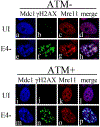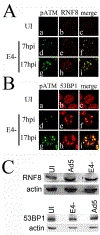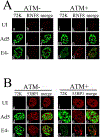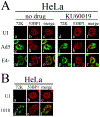Localization of the kinase Ataxia Telangiectasia Mutated to Adenovirus E4 mutant DNA replication centers is important for its inhibitory effect on viral DNA accumulation
- PMID: 30453211
- PMCID: PMC6874311
- DOI: 10.1016/j.virol.2018.11.003
Localization of the kinase Ataxia Telangiectasia Mutated to Adenovirus E4 mutant DNA replication centers is important for its inhibitory effect on viral DNA accumulation
Abstract
Adenovirus (Ad) type 5 (Ad5) E4 deletion mutants including H5dl1007 (E4-) induce a DNA damage response (DDR) that activates the kinase ataxia-telangiectasia mutated (ATM), which can interfere with efficient viral DNA replication. We find that localization of active phosphorylated ATM (pATM) to E4- viral replication centers (VRCs) is important for its inhibitory effect. ATM is necessary for localization of RNF8 and 53BP1 to E4 mutant VRCs, while recruitment of DDR factors Mre11, Mdc1 and γH2AX is ATM-independent, raising the possibility that ATM may affect viral chromatin at VRCs. We assessed E4- and Ad5 chromatin organization by micrococcal nuclease (MN) digestion. A significant fraction of Ad5 DNA is somewhat resistant to MN digestion, whereas E4- DNA is more susceptible. ATM inhibition increases the fraction of E4- DNA that is resistant to MN digestion. Our results address possible mechanisms through which ATM inhibits E4- DNA replication.
Keywords: 53BP1; ATM; Adenovirus; DNA damage response; E4 11 kDa; E4 34 kDa; E4 ORF 3; E4 ORF 6; Micrococcal nuclease; RNF8.
Copyright © 2018. Published by Elsevier Inc.
Figures







Similar articles
-
En Guard! The Interactions between Adenoviruses and the DNA Damage Response.Viruses. 2020 Sep 7;12(9):996. doi: 10.3390/v12090996. Viruses. 2020. PMID: 32906746 Free PMC article. Review.
-
An Adenovirus early region 4 deletion mutant induces G2/M arrest via ATM activation and reduces expression of the mitotic marker phosphorylated (ser10) histone 3.Virology. 2022 Jan 2;565:1-12. doi: 10.1016/j.virol.2021.09.006. Epub 2021 Sep 27. Virology. 2022. PMID: 34626906
-
The kinase activity of ataxia-telangiectasia mutated interferes with adenovirus E4 mutant DNA replication.J Virol. 2013 Aug;87(15):8687-96. doi: 10.1128/JVI.00376-13. Epub 2013 Jun 5. J Virol. 2013. PMID: 23740981 Free PMC article.
-
Viral and Cellular Genomes Activate Distinct DNA Damage Responses.Cell. 2015 Aug 27;162(5):987-1002. doi: 10.1016/j.cell.2015.07.058. Cell. 2015. PMID: 26317467 Free PMC article.
-
Formation of adenovirus DNA replication compartments.FEBS Lett. 2019 Dec;593(24):3518-3530. doi: 10.1002/1873-3468.13672. Epub 2019 Nov 26. FEBS Lett. 2019. PMID: 31710378 Review.
Cited by
-
En Guard! The Interactions between Adenoviruses and the DNA Damage Response.Viruses. 2020 Sep 7;12(9):996. doi: 10.3390/v12090996. Viruses. 2020. PMID: 32906746 Free PMC article. Review.
References
-
- Bakkenist CJ, Kastan MB, 2003. DNA damage activates ATM through intermolecular autophosphorylation and dimer dissociation. Nature 421 (6922), 499–506. - PubMed
-
- Bekker-Jensen S, Mailand N, 2010. Assembly and function of DNA double-strand break repair foci in mammalian cells. DNA Repair (Amst). 9 (12), 1219–1228. - PubMed
-
- Blackford AN, Jackson SP, 2017. ATM, ATR, and DNA-PK: The Trinity at the Heart of the DNA Damage Response. Mol. Cell 66 (6), 801–817. - PubMed
Publication types
MeSH terms
Substances
Grants and funding
LinkOut - more resources
Full Text Sources
Research Materials
Miscellaneous

